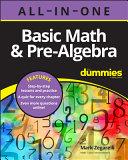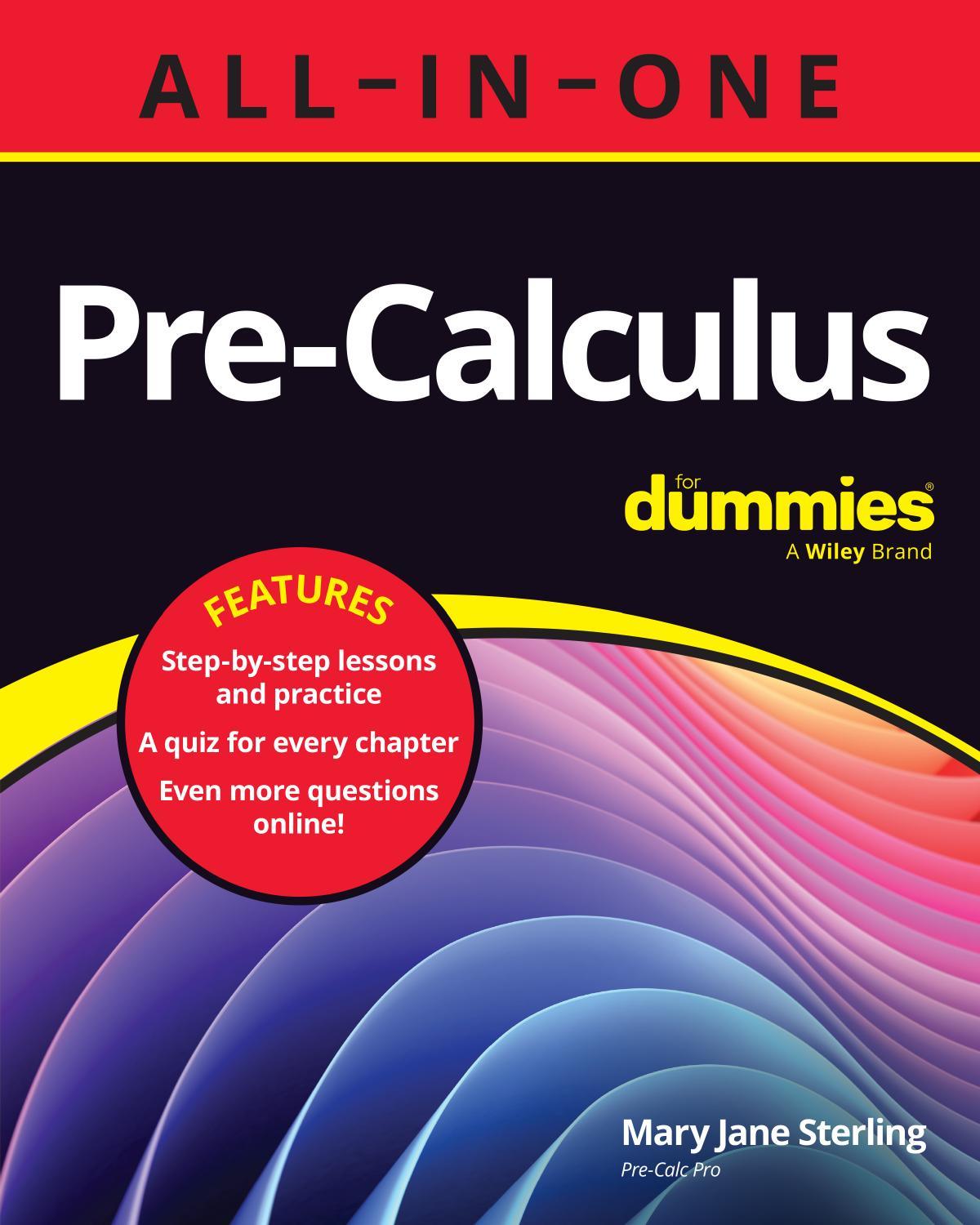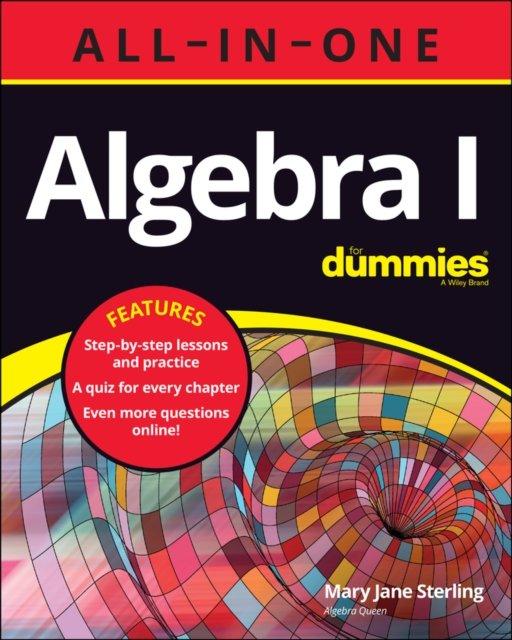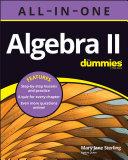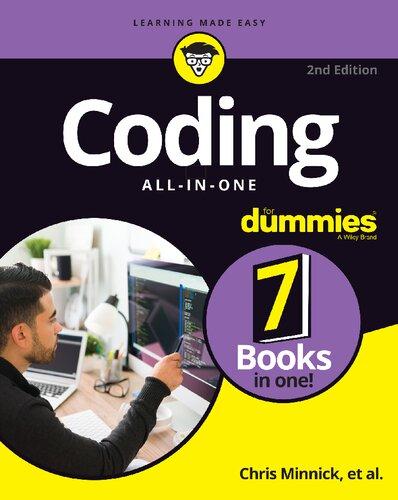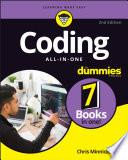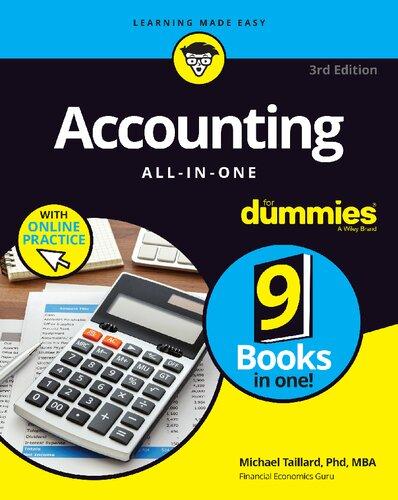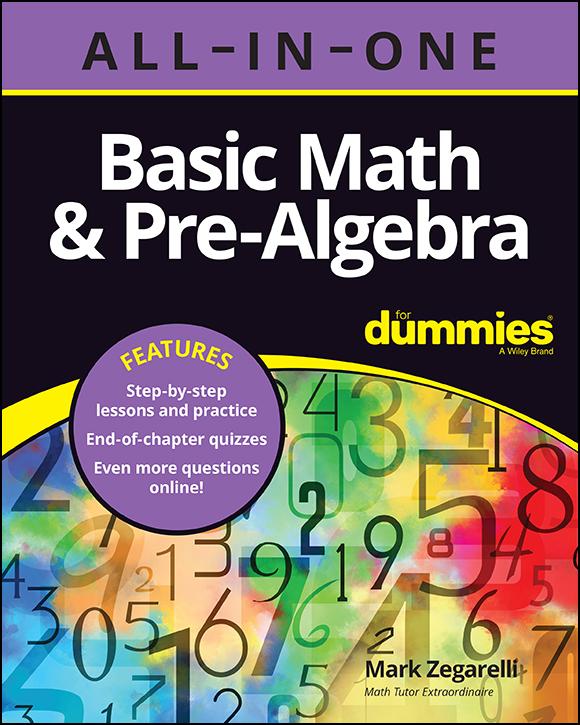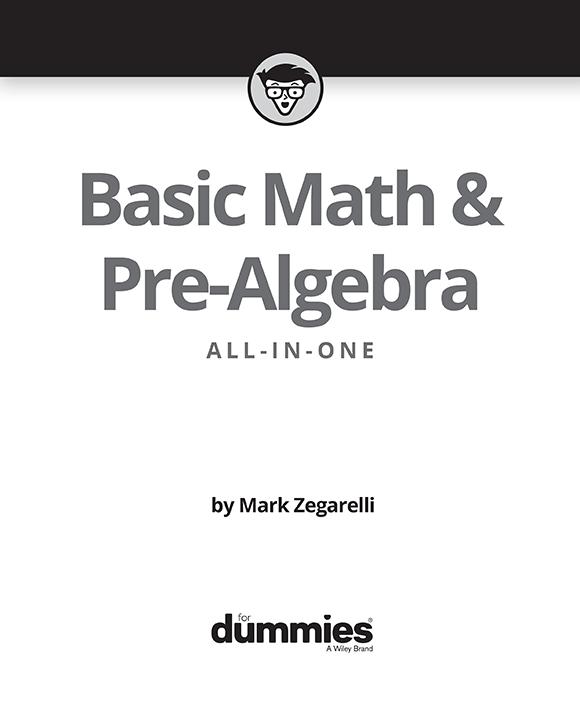Basic Math & Pre-Algebra All-in-One For Dummies®
Published by: John Wiley & Sons, Inc., 111 River Street, Hoboken, NJ 07030-5774, www.wiley.com
Copyright © 2022 by John Wiley & Sons, Inc., Hoboken, New Jersey
Published simultaneously in Canada
No part of this publication may be reproduced, stored in a retrieval system or transmitted in any form or by any means, electronic, mechanical, photocopying, recording, scanning or otherwise, except as permitted under Sections 107 or 108 of the 1976 United States
Copyright Act, without the prior written permission of the Publisher. Requests to the Publisher for permission should be addressed to the Permissions Department, John Wiley & Sons, Inc., 111 River Street, Hoboken, NJ 07030, (201) 748-6011, fax (201) 748-6008, or online at http://www.wiley.com/go/permissions.
Trademarks: Wiley, For Dummies, the Dummies Man logo, Dummies.com, Making Everything Easier, and related trade dress are trademarks or registered trademarks of John Wiley & Sons, Inc., and may not be used without written permission. All other trademarks are the property of their respective owners. John Wiley & Sons, Inc., is not associated with any product or vendor mentioned in this book.
LIMIT OF LIABILITY/DISCLAIMER OF WARRANTY: WHILE THE PUBLISHER AND AUTHORS HAVE USED THEIR BEST EFFORTS IN PREPARING THIS WORK, THEY MAKE NO REPRESENTATIONS OR WARRANTIES WITH RESPECT TO THE ACCURACY OR COMPLETENESS OF THE CONTENTS OF THIS WORK AND SPECIFICALLY DISCLAIM ALL WARRANTIES, INCLUDING WITHOUT LIMITATION ANY IMPLIED WARRANTIES OF MERCHANTABILITY OR FITNESS FOR A PARTICULAR PURPOSE. NO WARRANTY MAY BE CREATED OR EXTENDED BY SALES REPRESENTATIVES, WRITTEN SALES MATERIALS OR PROMOTIONAL STATEMENTS FOR THIS WORK. THE FACT THAT AN ORGANIZATION, WEBSITE, OR PRODUCT IS REFERRED TO IN THIS WORK AS A CITATION
AND/OR POTENTIAL SOURCE OF FURTHER INFORMATION DOES NOT MEAN THAT THE PUBLISHER AND AUTHORS ENDORSE THE INFORMATION OR SERVICES THE ORGANIZATION, WEBSITE, OR PRODUCT MAY PROVIDE OR RECOMMENDATIONS IT MAY MAKE. THIS WORK IS SOLD WITH THE UNDERSTANDING THAT THE PUBLISHER IS NOT ENGAGED IN RENDERING PROFESSIONAL SERVICES. THE ADVICE AND STRATEGIES CONTAINED HEREIN MAY NOT BE SUITABLE FOR YOUR SITUATION. YOU SHOULD CONSULT WITH A SPECIALIST WHERE APPROPRIATE. FURTHER, READERS SHOULD BE AWARE THAT WEBSITES LISTED IN THIS WORK MAY HAVE CHANGED OR DISAPPEARED BETWEEN WHEN THIS WORK WAS WRITTEN AND WHEN IT IS READ. NEITHER THE PUBLISHER NOR AUTHORS SHALL BE LIABLE FOR ANY LOSS OF PROFIT OR ANY OTHER COMMERCIAL DAMAGES, INCLUDING BUT NOT LIMITED TO SPECIAL, INCIDENTAL, CONSEQUENTIAL, OR OTHER DAMAGES.
For general information on our other products and services, please contact our Customer Care Department within the U.S. at 877-762-2974, outside the U.S. at 317-572-3993, or fax 317-572-4002. For technical support, please visit https://hub.wiley.com/community/support/dummies.
Wiley publishes in a variety of print and electronic formats and by printon-demand. Some material included with standard print versions of this book may not be included in e-books or in print-on-demand. If this book refers to media such as a CD or DVD that is not included in the version you purchased, you may download this material at http://booksupport.wiley.com. For more information about Wiley products, visit www.wiley.com.
Library of Congress Control Number: 2022932610
ISBN 978-1-119-86708-1 (pbk); ISBN 978-1-119-86748-7 (ebk); ISBN 978-1-119-86726-5 (ebk)
One For Dummies®
To view this book's Cheat Sheet, simply go to www.dummies.com and search for “Basic Math & Pre-Algebra All-in-One For Dummies Cheat Sheet” in the Search box.
Table of Contents
Cover Title Page
Copyright
Introduction About This Book
Foolish Assumptions Icons Used in This Book Beyond the Book Where to Go from Here
Unit 1: Getting Started with Basic Math & Pre-Algebra
Chapter 1: Playing the Numbers Game
Inventing Numbers
Understanding Number Sequences Four Important Sets of Numbers
Chapter 2: The Big Four Operations
The Big Four Operations
Applying the Big Four Operations to Larger Numbers
Unit 2: The Big Four Operations: Addition, Subtraction, Multiplication, and Division
Chapter 3: Counting on Success: Numbers and Digits
Knowing Your Place Value
Close Enough for Rock ‘n’ Roll: Rounding and Estimating
Practice Questions Answers and Explanations
Whaddya Know? Chapter 3 Quiz
Answers to Chapter 3 Quiz
Chapter 4: Staying Positive with Negative Numbers
Understanding Where Negative Numbers Come From
Sign-Switching: Understanding Negation and Absolute Value
Addition and Subtraction with Negative Numbers
Knowing Signs of the Times (and Division) for Negative Numbers
Practice Questions Answers and Explanations
Whaddya Know? Chapter 4 Quiz
Answers to Chapter 4 Quiz
Chapter 5: Putting the Big Four Operations to Work
Switching Things Up with Inverse Operations and the Commutative Property
Getting with the In-Group: Parentheses and the Associative Property
Understanding Inequalities
Moving Beyond the Big Four: Exponents and Square Roots
Practice Questions Answers and Explanations
Whaddya Know? Chapter 5 Quiz
Answers to Chapter 5 Quiz
Unit 3: Getting a Handle on Whole Numbers
Chapter 6: Please Excuse My Dear Aunt Sally: Evaluating Arithmetic Expressions with PEMDAS
The Three E’s of Math: Equations, Expressions, and Evaluation Introducing Order of Operations (PEMDAS)
Handling Powers Responsibly
Bringing It All Together: The Order of Operations
Practice Questions Answers and Explanations
Whaddya Know? Chapter 6 Quiz
Answers to Chapter 6 Quiz
Chapter 7: Turning Words into Numbers: Basic Math
Word Problems
Dispelling Two Myths about Word Problems
Solving Basic Word Problems
Solving More-Complex Word Problems
Practice Questions Answers and Explanations
Whaddya Know? Chapter 7 Quiz
Answers to Chapter 7 Quiz
Chapter 8: Divisibility and Prime Numbers
Knowing the Divisibility Tricks
Identifying Prime and Composite Numbers
Practice Questions Answers and Explanations
Whaddya Know? Chapter 8 Quiz
Answers to Chapter 8 Quiz
Chapter 9: Divided Attention: Factors and Multiples
Knowing Six Ways to Say the Same Thing
Understanding Factors and Multiples
Finding Fabulous Factors
Generating a Number’s Factors
Decomposing a Number into Its Prime Factors
Finding the Greatest Common Factor
Generating the Multiples of a Number
Finding the Least Common Multiple
Practice Questions Answers and Explanations
Whaddya Know? Chapter 9 Quiz
Answers to Chapter 9 Quiz
Chapter 10: Understanding Fractions
Slicing a Cake into Fractions
Knowing the Fraction Facts of Life
Increasing and Reducing Terms of Fractions
Converting between Improper Fractions and Mixed Numbers
Comparing Fractions with Cross-Multiplication
Working with Ratios and Proportions
Practice Questions Answers and Explanations
Whaddya Know? Chapter 10 Quiz
Answers to Chapter 10 Quiz
Chapter 11: Fractions and the Big Four Operations
Multiplying and Dividing Fractions
Adding and Subtracting Fractions with the Same Denominator
Adding and Subtracting Fractions with Different Denominators
Practice Questions Answers and Explanations
Whaddya Know? Chapter 11 Quiz
Answers to Chapter 11 Quiz
Chapter 12: Mixing Things Up with Mixed Numbers
Multiplying and Dividing Mixed Numbers
Adding Mixed Numbers
Subtracting Mixed Numbers
Practice Questions Answers and Explanations
Whaddya Know? Chapter 12 Quiz
Answers to Chapter 12 Quiz
Unit 5: Decimals and Percents
Chapter 13: Getting to the Point with Decimals
Understanding Basic Decimal Stuff
Performing the Big Four Operations with Decimals
Converting between Decimals and Fractions
Simple Decimal-Fraction Conversions
Practice Questions Answers and Explanations
Whaddya Know? Chapter 13 Quiz
Answers to Chapter 13 Quiz
Chapter 14: Playing the Percentages
Making Sense of Percentages
Dealing with Percentages Greater than 100%
Converting to and from Percentages, Decimals, and Fractions
Converting Percentages to Decimals
Changing Decimals to Percentages
Switching from Percentages to Fractions
Converting Fractions to Percentages
Solving Percentage Problems
Putting All the Percent Problems Together
Solving Percent Problems with Equations
Practice Questions Answers and Explanations
Whaddya Know? Chapter 14 Quiz
Answers to Chapter 14 Quiz
Chapter 15:
Word Problems with Fractions, Decimals, and Percentages
Adding and Subtracting Parts of the Whole in Word Problems
Problems about Multiplying Fractions
Multiplying Decimals and Percentages in Word Problems
Handling Percent Increases and Decreases in Word Problems
Practice Questions Answers and Explanations
Whaddya Know? Chapter 15 Quiz
Answers to Chapter 15 Quiz
Unit 6:
Reaching the Summit: Advanced Pre-Algebra Topics
Chapter 16: Powers and Roots
Memorizing Powers and Roots
Changing the Base
Exponents of 0 and Negative Numbers
Fractional Exponents
Practice Questions Answers and Explanations
Whaddya Know? Chapter 16 Quiz
Answers to Chapter 16 Quiz
Chapter 17: A Perfect Ten: Condensing Numbers with Scientific Notation
First Things First: Using Powers of Ten as Exponents
Exponential Arithmetic: Multiplying and Dividing Powers of Ten
Working with Scientific Notation
Dividing with Scientific Notation
Practice Questions Answers and Explanations
Whaddya Know? Chapter 17 Quiz
Answers to Chapter 17 Quiz
Chapter
18:
How Much Have You Got? Weights and Measures
Understanding Units
Examining Differences between the English and Metric Systems
Estimating and Converting between the English and Metric Systems
Converting between English and Metric Units
Practice Questions Answers and Explanations
Whaddya Know? Chapter 18 Quiz
Answers to Chapter 18 Quiz
Chapter 19: Getting the Picture with Geometry
Getting on the Plane: Points, Lines, Angles, and Shapes
Getting in Shape: Polygon (and Non-Polygon) Basics
Closed Encounters: Shaping Up Your Understanding of 2-D Shapes
Squaring Off with Quadrilaterals
Making a Triple Play with Triangles
Getting Around with Circle Measurements
Taking a Trip to Another Dimension: Solid Geometry
Building Solid Measurement Skills
Solving Geometry Word Problems
Practice Questions Answers and Explanations
Whaddya Know? Chapter 19 Quiz
Answers to Chapter 19 Quiz
Chapter 20: Figuring Your Chances: Statistics and Probability
Gathering Data Mathematically: Basic Statistics
Looking at Likelihoods: Basic Probability
Practice Questions Answers and Explanations
Whaddya Know? Chapter 20 Quiz
Answers to Chapter 20 Quiz
Chapter 21: Setting Things Up with Basic Set Theory
Understanding Sets
Performing Operations on Sets
Practice Questions Answers and Explanations
Whaddya Know? Chapter 21 Quiz
Answers to Chapter 21 Quiz
Unit 7: The X-Files: Introduction to Algebra
Chapter 22: Working with Algebraic Expressions
Seeing How X Marks the Spot
Expressing Yourself with Algebraic Expressions
Evaluating Algebraic Expressions
Knowing the Terms
Adding and Subtracting Like Terms
Multiplying and Dividing Terms
Simplifying Expressions by Combining Like Terms
Removing Parentheses from an Algebraic Expression
FOILing: Dealing with Two Sets of Parentheses
Practice Questions Answers and Explanations
Whaddya Know? Chapter 22 Quiz
Answers to Chapter 22 Quiz
Chapter 23: Solving Algebraic Equations
Understanding Algebraic Equations
The Balancing Act: Solving for x
Rearranging Equations and Isolating x
Practice Questions Answers and Explanations
Whaddya Know? Chapter 23 Quiz
Answers to Chapter 23 Quiz
Chapter 24: Tackling Algebra Word Problems
Solving Algebra Word Problems in Five Steps
Choosing Your Variable Wisely
Solving More-Complex Algebraic Problems
Practice Questions Answers and Explanations
Whaddya Know? Chapter 24 Quiz
Answers to Chapter 24 Quiz
Chapter 25: Graphing Algebraic Equations
Graphing on the xy-Plane
Understanding Linear Equations
Measuring the Slope of a Line
Graphing Linear Equations Using the Slope and y-intercept
Practice Questions Answers and Explanations
Whaddya Know? Chapter 25 Quiz
Answers to Chapter 25 Quiz
Index
About the Author
Advertisement Page
Connect with Dummies
End User License Agreement
List of Tables
Chapter 3
Table 3-1 45,019 Displayed in a Place-Value Chart
Table 3-2 5,001,000 Displayed Incorrectly without Placeholding Zeros
Table 3-3 3,040,070 Displayed with Two Leading Zeros
Table 3-4 A Place-Value Chart Separated by Commas
Chapter 13
Table 13-1 Breaking Down 4,672 in Terms of Place Value
Table 13-2 Breaking Down the Decimal 4,672.389
Table 13-3 Example of Attaching Leading Zeros
Table 13-4 Example of Attaching Trailing Zeros
Table 13-5 Example of Zeros as Placeholders
Table 13-6 Example of Decimal Points and Place Value of Digits
Table 13-7 Example of Numbers Shifting One Place
Chapter 14
TABLE 14-1 The Three Main Types of Percent Problems
Chapter 17
Table 17-1 Powers of Ten Expressed as Exponents
Chapter 18
Table 18-1 Commonly Used English Units of Measurement
Table 18-2 Five Basic Metric Units
Table 18-3 Ten Metric Prefixes
Table 18-4 Comparing Celsius and Fahrenheit Temperatures
Table 18-5 Conversion Factors for English and Metric Units
Chapter 20
Table 20-1 Sister Elena’s Fifth-Grade Survey
Table 20-2 Favorite Colors in Sister Elena’s Class
Table 20-3 Height and Spelling Test Scores
Chapter 25
Table 25-1 Plotting the Points for the Linear Equation .
Table 25-2 The Slope and y-Intercept of Three Linear Equations
List of Illustrations
Chapter 1
FIGURE 1-1: Square numbers.
FIGURE 1-2: The number 12 laid out in two rectangular patterns.
FIGURE 1-3: Composite numbers, such as 8 and 15, can form rectangles.
FIGURE 1-4: Unlucky 13, a prime example of a number that refuses to fit in a bo...
Chapter 4
FIGURE 4-1: Negative numbers on the number line.
Chapter 10
FIGURE 10-1: Two halves of a cake.
FIGURE 10-2: Cake cut into thirds.
FIGURE 10-3: Cakes cut and shaded into
FIGURE 10-4: Cakes cut and shaded into
Chapter 13
FIGURE 13-1: One-half (0.5) of a dollar bill.
FIGURE 13-2: One-fourth (0.25) of a dollar bill.
FIGURE 13-3: Three-fourths (0.75) of a dollar bill.
FIGURE 13-4: Cakes cut and shaded into (A) 0.75, (B) 0.4, (C) 0.1, and (D) 0.7....
Chapter 19
FIGURE 19-1: Unnamed shapes.
FIGURE 19-2: Types of triangles.
FIGURE 19-3: Common quadrilaterals.
FIGURE 19-4: A pentagon, a hexagon, and an octagon.
FIGURE 19-5: Various irregular polygons.
FIGURE 19-6: The area and perimeter of a square using the length of a side (s)
FIGURE 19-7: The area and perimeter of a rectangle using the length (l) and wid...
FIGURE 19-8: The area of a rhombus or parallelogram using the base (b) and heig...
FIGURE 19-9: The area of a trapezoid using the length of the two bases (b1 and
FIGURE 19-10: The area of a triangle using the base (b) and height (h).
FIGURE 19-11: Using the Pythagorean Theorem to find the hypotenuse (c) of a rig...
FIGURE 19-12: The area and circumference of a circle using the radius (r).
FIGURE 19-13: A typical cube.
FIGURE 19-14: Common polyhedrons.
FIGURE 19-15: The five regular solids.
FIGURE 19-16: Spheres, cylinders, and cones.
FIGURE 19-17: The volume of a cube using the length of a side (s).
FIGURE 19-18: The volume of a box using the length (l), width (w), and height (
FIGURE 19-19: The volume of a prism or cylinder using the area of the base (Ab)...
FIGURE 19-20: The volume of a pyramid or cone using the area of the base (Ab) a...
FIGURE 19-21: The volume of a sphere using the radius (r).
FIGURE 19-22: Two sons get nonrectangular portions of a rectangular field.
FIGURE 19-23: A labeled sketch shows the important information in a word proble...
FIGURE 19-24: Update the labels in your sketch as you work through the problem.
Chapter 23
FIGURE 23-1: Showing how an equation is similar to a balance scale.
Chapter 25
FIGURE 25-1: The xy-plane.
FIGURE 25-2: Plotting four points on the xy-plane: , , , and
FIGURE 25-3: Graphing the equation .
FIGURE 25-4: The graph of on the xy-plane.
FIGURE 25-5: The graph of on the xy-plane for three positive values of m
FIGURE 25-6: The graph of on the xy-plane for three negative values of m.
FIGURE 25-7: The graph of on the xy-plane for three positive values of b
FIGURE 25-8: The graph of on the xy-plane for three negative values of b
FIGURE 25-9: Four linear equations graphed on the xy-plane.
FIGURE 25-10: Graphing slopes of 1, 0, and –1.
FIGURE 25-11: Graphing positive and negative slopes.
Chapter 1 Playing the Numbers Game
IN THIS CHAPTER
Finding out how numbers were invented
Looking at a few familiar number sequences
Examining the number line
Understanding four important sets of numbers
One useful characteristic of numbers is that they’re conceptual, which means that, in an important sense, they’re all in your head. (This fact probably won’t get you out of having to know about them, though — nice try!)
For example, you can picture three of anything: three cats, three baseballs, three tigers, three planets. But just try to picture the concept of three all by itself, and you find it’s impossible. Oh, sure, you can picture the numeral 3, but threeness itself — much like love or beauty or honor — is beyond direct understanding. But when you understand the concept of three (or four, or a million), you have access to an incredibly powerful system for understanding the world: mathematics.
In this chapter, I give you a brief history of how numbers likely came into being. I discuss a few common number sequences and show you how these connect with simple math operations like addition, subtraction, multiplication, and division.
After that, I describe how some of these ideas come together with a simple yet powerful tool: the number line. I discuss how numbers are arranged on the number line, and I also show you how to use the number line as a calculator for simple arithmetic. Finally, I describe how the counting numbers (1, 2, 3, …) sparked the invention of more unusual types of numbers, such as negative numbers, fractions, and irrational
numbers. I also show you how these sets of numbers are nested — that is, how one set of numbers fits inside another, which fits inside another.
Inventing Numbers
Historians believe that the first written number systems came into being at the same time as agriculture and commerce. Before that, people in prehistoric, hunter-gatherer societies were pretty much content to identify bunches of things as “a lot” or “a little.” They may have had concepts of small numbers, probably less than five or ten, but lacked a coherent way to think about, for example, the number 42.
Throughout the ages, the Babylonians, Egyptians, Greeks, Hindus, Romans, Mayans, Arabs, and Chinese (to name just a few) all developed their own systems of writing numbers.
Although Roman numerals gained wide currency as the Roman Empire expanded throughout Europe and parts of Asia and Africa, the more advanced system that was invented in India and adapted by the Arabs turned out to be more useful. Our own number system, the Hindu-Arabic numbers (also called decimal numbers), is mainly derived from these earlier number systems.
Understanding Number Sequences
Although humans invented numbers for counting commodities, as I explain in the preceding section, they soon put them to use in a wide range of applications. Numbers were useful for measuring distances, counting money, amassing armies, levying taxes, building pyramids, and lots more.
But beyond their many uses for understanding the external world, numbers have an internal order all their own. So numbers are not only an invention, but equally a discovery: a landscape reflecting fundamental truths about nature, and how humans think about it, that seems to exist independently, with its own structure, mysteries, and even perils.
One path into this new and often strange world is the number sequence: an arrangement of numbers according to a rule. In the following sections, I introduce you to a variety of number sequences that are useful for making sense of numbers.
Evening the odds
One of the first facts you probably heard about numbers is that all of them are either even or odd. For example, you can split an even number of marbles evenly into two equal piles. But when you try to divide an odd number of marbles the same way, you always have one odd, leftover marble. Here are the first few even numbers:
You can easily keep the sequence of even numbers going as long as you like. Starting with the number 2, keep adding 2 to get the next number. Similarly, here are the first few odd numbers:
The sequence of odd numbers is just as simple to generate. Starting with the number 1, keep adding 2 to get the next number.
Patterns of even or odd numbers are the simplest number patterns around, which is why kids often figure out the difference between even and odd numbers soon after learning to count.
Counting by threes, fours, fives, and so on
When you get used to the concept of counting by numbers greater than 1, you can run with it. For example, here’s what counting by threes, fours, and fives looks like:
Counting by a given number is a good way to begin learning the multiplication table for that number, especially for the numbers you’re kind of sketchy on. (In general, people seem to have the most trouble multiplying by 7, but 8 and 9 are also unpopular.)
These types of sequences are also useful for understanding factors and multiples, which you get a look at in Chapter 9.
Getting square with square numbers
When you study math, sooner or later, you probably want to use visual aids to help you see what numbers are telling you. (Later in this book, I show you how one picture can be worth a thousand numbers when I discuss geometry in Chapter 19 and graphing in Chapter 25.)
The tastiest visual aids you’ll ever find are those little square cheeseflavored crackers. (You probably have a box sitting somewhere in the pantry. If not, saltine crackers or any other square food works just as well.) Shake a bunch out of a box and place the little squares together to make bigger squares. Figure 1-1 shows the first few.
© John Wiley & Sons, Inc.
FIGURE 1-1: Square numbers.
Voilà! The square numbers:
You get a square number by multiplying a number by itself, so knowing the square numbers is another handy way to remember part of the multiplication table. Although you probably remember without help that 2 × 2 = 4, you may be sketchy on some of the higher numbers, such as 7 × 7 = 49. Knowing the square numbers gives you another way to etch that multiplication table forever into your brain.
Square numbers are also a great first step on the way to understanding exponents, which I introduce later in this chapter and explain in more detail in Chapter 5.
Composing yourself with composite numbers
Some numbers can be placed in rectangular patterns. Mathematicians probably should call numbers like these “rectangular numbers,” but instead they chose the term composite numbers. For example, 12 is a composite number because you can place 12 objects in rectangles of two different shapes, as in Figure 1-2.

